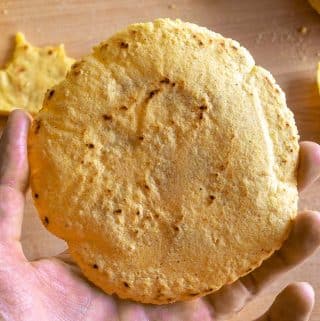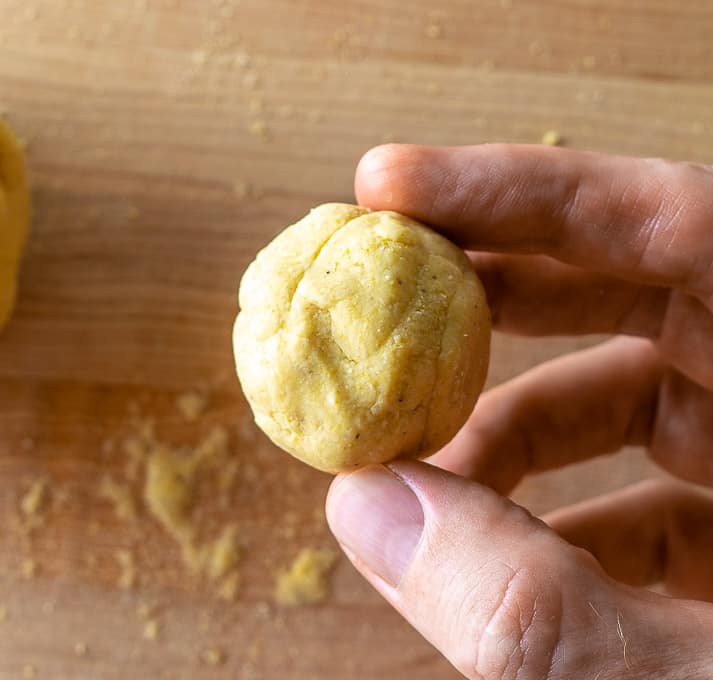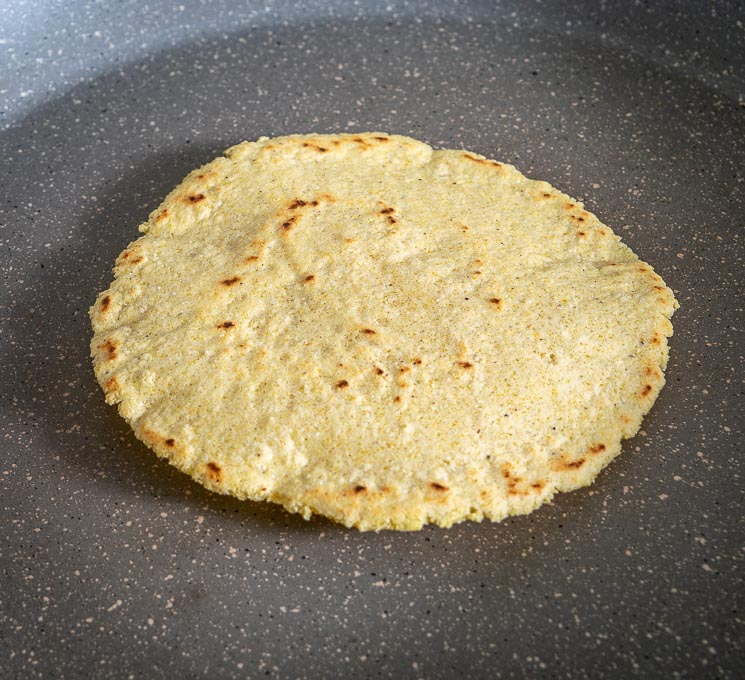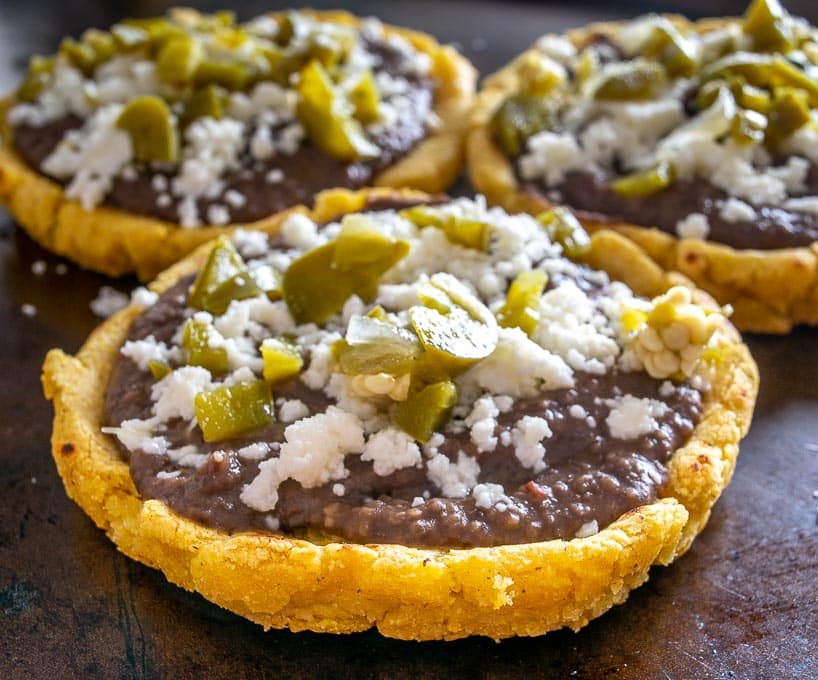Flour tortillas are made with fat, but corn tortillas aren't. That's one of the unspoken rules of Mexican cuisine.
But why? And what happens if you break the rules?!!
Let's find out...
Making Corn Tortillas With Some Lard
I'll go through the process of making corn tortillas in this post, but if you're new to them then definitely check out the Homemade Corn Tortillas post as it has all the tips you'll need to make a frustration-free batch.
I've been going with Bob's Red Mill Masa Harina lately, but there are other brands that will give you good results too. Here are the 3 main brands you can choose from.
A traditional recipe for corn tortillas, fat-free, looks like this:
2 cups Masa Harina What exactly is Masa Harina?
1/2 teaspoon salt
1.5 cups warm water
So I'll use that as a starting point, but I'll cut it in half for all of these test batches.
First up we'll make a normal, fat-free batch and compare it to a batch made with some lard.
I'm using home-rendered lard. If you're curious about it then check out this lard post. Store-bought could work too, but I tend to stay away from the lard in the baking aisle as it is hydrogenated.
So each of these batches will use:
1 cup Masa Harina
1/4 teaspoon salt
0.75 cup warm water
And we'll add a single tablespoon of lard to the batch on the left.
Combine using a spoon or spatula, and then I usually dump it onto a work surface and use my hands to finish it.
Sometimes it can help to add those final bits of water incrementally to help get the consistency of the dough right.
If it's sticking to your hands then there's a bit too much water and you can just add a sprinkling of Masa Harina to dry it out. Conversely, if it's crumbly and not coming together then you need to add more water.
Pull off a golfball-sized chunk and roll it between your hands.
I use a Ziploc to surround the dough ball when flattening it.
And to prove that you don't need a tortilla press, I used a casserole dish to flatten these dough balls.
Add the flattened tortilla to a pre-heated dry skillet and flip after 10 seconds, then let each side cook for 45-60 seconds or until light brown spots are forming on the underside. Just over medium heat does the job on my stove.
So here they are side by side, with the lard batch on the left:
Yes, most of these batches will look identical, but what about the flavor?!!
First I should mention that both are significantly better than store-bought tortillas, so that's the baseline that we're starting with.
The batch made with lard definitely has a bump in flavor. They are a little more savory, almost a little more salty too, and they are definitely capable of being eaten on their own.
Good to know!
Next, I wanted to test out the lard amount so I made a batch with double the lard, i.e. two tablespoons of lard were added to a single cup of Masa Harina.
Doubling the lard made the dough lighter and almost a little fluffy, and it came together much more readily than fat-free batches.
But once cooked the flavor seemed nearly identical to the batch made with a single tablespoon of lard. I was a little surprised by this, but good to know!
I was also curious to see if doubling the lard would make them crisp up a little more in the skillet, with visions of a half tortilla, half tostada creation that would revolutionize my kitchen.
But alas, they did not crisp up at all in the skillet! In fact they seemed to cook almost identically to the batch made with a single tablespoon of lard.
I also wanted to test out different fats so I made batches with olive oil and butter.
So in the above pic the batch on the left has a single tablespoon of olive oil, and the batch on the right has a single tablespoon of melted butter.
And the taste result?
Hmmm....there was no taste improvement at all for the olive oil batch. In fact I got a scent of the olive oil I used and now I know that I don't want that flavor in my corn tortillas 🙂
And the butter batch had some additional savoriness compared to fat-free tortillas, but not as much as the lard batch.
So what did I learn?
Well...homemade corn tortillas are awesome 🙂 Any of these batches will outperform store-bought tortillas.
But making a batch WITH fat does give you a slight bump in flavor, and this bump is most pronounced when using lard -- at least according to my palate.
I frequently make bare bones, on-the-fly meals like this:
For simple meals like that I would definitely reach for a tortilla made with lard for some additional flavor. When the tortilla takes on a bigger role then you'll benefit by using a tortilla that is slightly more savory.
But for meals like Chicken Tacos where the tortilla is loaded up with fixings, then I'll reach for traditional batches of fat-free corn tortillas because you won't be able to tell the difference when there are so many competing flavors.
Most importantly though, all of this is kinda dependent on your taste buds, so feel free to experiment if it interests you.
And if you want to experiment NOW but don't have access to good lard, then just save your bacon drippings and use a tablespoon of that. It will be close enough to lard and it will instantly give you a sense of whether you like fat in your corn tortillas.
Buen Provecho.
Want the latest recipe? Click your favorite from these options and follow me: Instagram, Facebook, Pinterest, TikTok, YouTube.

Corn Tortillas Made With Fat
Ingredients
- 2 cups Masa Harina
- 2 tablespoons lard
- 1/2 teaspoon salt
- 1.5 cups warm water
Instructions
- Add 2 cups Masa Harina, 2 tablespoons lard, and 1/2 teaspoon salt to a mixing bowl. Add 1 cup of the warm water and stir until the water is absorbed. Add the rest of the water incrementally until the flour melds into a dough. Use your hands to knead the dough into a cohesive ball.
- Separate the dough into golf ball sized chunks -- this will make tortillas approximately 4 inches across. Flatten the dough balls using a flat bottomed pan or a tortilla press. Be sure to line each side of the dough ball with plastic or Ziploc pieces
- Heat a skillet or comal to medium-high heat. Add a tortilla to the skillet and flip it after 10 seconds. Then cook each side for about a minute or until light brown spots are forming on the underside. (Lately I use a tad over medium heat on my stove and this will have brown spots forming in about 60 seconds.)
- Continue cooking the rest of the tortillas. I usually put one in the skillet and flatten the next one to expedite the process. Once cooked you can keep them warm by wrapping them in a tea towel or using a dedicated tortilla warmer. Serve immediately.
- Store leftovers tortillas in an airtight container in the fridge. To reheat, cook them in a dry skillet over medium heat until warm and crispy.
Notes
Want to see the latest recipe? It's these Sopes with Refried Beans and Cheese.
Still hungry?!
Want to receive Mexican Please recipes via email when they are posted? Sign up below to subscribe. All recipes are spam free.















Sharon
Hello, I enjoyed reading your posting. Have you tried half and half tortillas? Made with half masa and half flour, water, salt and, lard.
Patrick
Hey Sharon! Yeah I buy those half-and-halfs occasionally and like them. I've been meaning to experiment with a recipe for them and hope to get to it soon. Cheers.
patrick rosello
I really appreciate your experimental process and observations, it saves me time!
I am looking for the best tortilla recipe that will suit my needs, for breakfast tacos in UK restaurant. I will definitely try to put some fat in my next batch, small adaptations can make the difference. many thanks!
Patrick
Thanks P, I hope you find a good combo for your breakfast tacos. Cheers.
Maureen Tilton
Thanks for the tips. About to turn on the heat.
Best wishes!
Patrick
Good luck Maureen, I hope they treat you well!
Sharon
I found your websight searching for a corn tortilla recipe. I've been making my own for a while and they come out tasty and good but they are not so pliable. Mine and just masa carina, flour and salt. They don't really fold well or roll. I have a recipe that I need to fill the tortillas and roll them and them bake them with a sauce. Do you think the tortillas made with fat roll up better? I've never been able to figure out how to get my tortillas more pliable. Thank you.
Patrick
Hey Sharon! I didn't try making enchiladas or anything like that with all the experiments in this post, but I do think you'll notice a difference in your tortillas if you add in some fat. The dough seems to get a little more forgiving and this should translate to less cracking when you are rolling them up -- just be sure to warm up your tortillas before rolling. If you notice any cracking, try the microwave method to warm them up as this can hydrate them a bit. Cheers.
How To Warm Up Corn Tortillas
Wayne
There’s a restaurant that makes a corn meal puffy taco. Any ideas on how they make the tortilla? I know deep frying is part of it but why isn’t it heavy like cornbread?
Patrick
Hey Wayne! Those puffy tacos are usually made from masa dough -- you can use Masa Harina to get a similar result at home. I think the key is to make sure there is plenty of hot oil on top when frying (by basting them) so that some air will get trapped inside, causing them to puff up. Cheers.
Jim Fuller
I’ve tried this before but didn’t have much success. I was trying to make a thin street tortilla as mine are always too thick. Do you have any suggestions?
We had
, we’ve moved from that area, a favorite restaurant that made everything homemade with the best tortillas But I just cant duplicate the thinness.
Patrick
Hey Jim! Yup I know exactly where you're at -- I was obsessed with getting them thin when first making corn tortillas. A couple things will help...
I have better luck getting them thin without a tortilla press -- using a casserole dish or skillet helps you dig into the center of the tortilla and I can get them thinner this way. I experimented with a rolling pin too, but found this could sometimes make them too thin i.e. they were too fragile and would frequently break apart when getting them off the Ziploc.
Making them smaller can help too as this makes them easier to handle and less likely to break apart when peeling off the plastic/Ziploc.
And last I should mention that it seemed like adding lard made them squish easier -- I wasn't 100pct positive on this but it seemed like there was less resistance from the lard batch when flattening them, and overall the dough was easier to work with so this could be an option if you are going to do some experimenting.
Okay I hope that helps a bit. Although I never got them EXACTLY how I envisioned them, I got pretty darn close and no longer feel like I need them any thinner. Cheers.
Humberto
Hi Patrick, great kitchen lab you showed us today! I experimented a few weeks back with veg. Oil in search of more "flexibility" in my totillas to prevent them from breaking up with the filling. They were great and the flavor improved. Now I will make them with bacon fat following your suggestion. I'll bet the pork carnitas tacos will taste awesome!
Thanks for improving my cooking!
Humberto
Patrick
Thanks Humberto!
Ed Quinn
I am very curious about the lard tortilla. Are they more flexible and less likely to break?
Patrick
Hey Ed! Yeah the dough is definitely more malleable and easier to work with. I haven't tried them for enchiladas yet, but adding lard (or any fat) should make them less likely to crack. Cheers.
Veea’ne
Hi Patrick,
Reading your experimenting, made me think of delicious little Masa Harina dumplings ( Chochoytes ) in a flavorful tomatillo chili chicken stock . Thanks for sharing 😉
Patrick
Thanks much for mentioning this Veea'ne, those Chochoyotes have been on my recipe to-do list for awhile now and I hope to post a version soon. Cheers.
Becky Turner
So the question is do the tortillas made with lard hold up well as tacos or enchiladas
Patrick
Hi Becky! I haven't tried these in enchiladas yet, but I think adding any fat to tortillas will make them less likely to crack or break apart. Cheers.